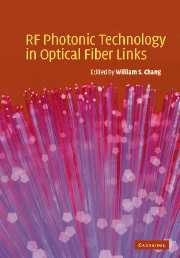Book contents
- Frontmatter
- Contents
- List of contributors
- Introduction and preface
- 1 Figures of merit and performance analysis of photonic microwave links
- 2 RF subcarrier links in local access networks
- 3 Analog modulation of semiconductor lasers
- 4 LiNbO3 external modulators and their use in high performance analog links
- 5 Broadband traveling wave modulators in LiNb03
- 6 Multiple quantum well electroabsorption modulators for RF photonic links
- 7 Polymer modulators for RF photonics
- 8 Photodiodes for high performance analog links
- 9 Opto-electronic oscillators
- 10 Photonic link techniques for microwave frequency conversion
- 11 Antenna-coupled millimeter-wave electro-optical modulators
- 12 System design and performance of wideband photonic phased array antennas
- Index
- References
8 - Photodiodes for high performance analog links
Published online by Cambridge University Press: 06 July 2010
- Frontmatter
- Contents
- List of contributors
- Introduction and preface
- 1 Figures of merit and performance analysis of photonic microwave links
- 2 RF subcarrier links in local access networks
- 3 Analog modulation of semiconductor lasers
- 4 LiNbO3 external modulators and their use in high performance analog links
- 5 Broadband traveling wave modulators in LiNb03
- 6 Multiple quantum well electroabsorption modulators for RF photonic links
- 7 Polymer modulators for RF photonics
- 8 Photodiodes for high performance analog links
- 9 Opto-electronic oscillators
- 10 Photonic link techniques for microwave frequency conversion
- 11 Antenna-coupled millimeter-wave electro-optical modulators
- 12 System design and performance of wideband photonic phased array antennas
- Index
- References
Summary
Introduction
The optical detector plays an important role in an analog fiber link as its performance determines the baseline characteristics of the link. In the past, the development of the detector has evolved around on-off operation, high speed and high responsivity aspects due to its extensive uses in digital fiber links. However, for analog applications, as discussed in Chapter 1, the detector has to incorporate additional designs to ensure high power and high linear dynamic range operation, both of which are essential for meeting the high link gain and low noise figure requirements.
The organization of this chapter goes as follows. In the remainder of this section an overall view of optical detection is presented including key terminology and figures of merit. Section 8.2 compares the baseline properties of different photodiodes. Section 8.3 briefly discusses the noise sources for photodiodes, with special attention to shot noise and noise attributed to laser relative intensity noise. These noise sources are dependent on the optical power. Section 8.4 highlights the research status of photodiode nonlinearity. Section 8.5 presents some recent advances in photodiodes related to analog fiber link applications.
Definitions
Semiconductor materials are commonly employed for optical detectors mainly because the resultant detectors are usually small, low noise, operate with a low voltage, and can be easily assembled with the rest of the receiver circuits. Photons interact with electrons in semiconductors and are absorbed in processes whereby electrons make a transition from a lower to a higher energy state.
- Type
- Chapter
- Information
- RF Photonic Technology in Optical Fiber Links , pp. 231 - 254Publisher: Cambridge University PressPrint publication year: 2002
References
- 2
- Cited by



